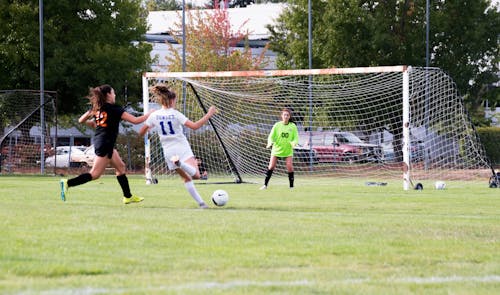Players in Kansas City used to change in parking lots. On Saturday, the city’s newest club opened the first purpose-built stadium for a women’s professional team.
By Brady Oltmans in Kansas City
Tue 19 Mar 2024 09.00 GMT
Share
With strength, speed, and courage, Temwa Chawinga created an opening in the Portland defense. She sprinted past a defender to beat the oncoming Portland goalkeeper Shelby Hogan, who parried the ball away. Teenager Alex Pfeiffer saw an opportunity, closed in, and slotted home her left-footed shot. Music, smoke, and pyrotechnics erupted at the Kansas City Riverfront. Kansas City Current led Portland Thorns 5-1.

The brand-new CPKC Stadium, the world’s first purpose-built for a women’s professional team, shone in the Missouri midday sun, delighting 11,500 fans. At 16 years, three months, and 20 days, Pfeiffer became the youngest goal scorer in National Women’s Soccer League history.
“This will change women’s soccer,” said Kansas City head coach Vlatko Andonovski after the game. “This is the beginning of a change.”
After Pfeiffer’s goal, momentum shifted quickly, and Portland responded with three goals in the last 20 minutes, forcing a sold-out crowd to endure seven minutes of stoppage time. If the kickoff brought a cathartic burst, the final whistle was a long exhale.
Soccer fans in Kansas City clung to the 5-4 victory, nearly losing it. It was no easy game for the home team on Saturday. But their entire journey to having their own place wasn’t easy either.
Kansas City lays claim to the title of “Soccer Capital of America” due to its rich soccer history. It has hosted several World Cup qualifiers, Concacaf Gold Cups, and Olympic preliminary games. It will host six more games at the 2026 World Cup, including a quarterfinal. The city failed in its bid to host games at the 1994 World Cup, but the tournament’s popularity laid the groundwork for the Kansas City Wizards, one of the founding clubs of Major League Soccer.

Almost two decades later, the city welcomed a franchise with the birth of the National Women’s Soccer League. The first NWSL game was kicked off on April 13, 2013 – coincidentally between FC Kansas City and Portland Thorns – 18 kilometers south of where the last Saturday game took place.
Support from federations in Canada, Mexico, and the USA allayed concerns that the league, like everything before it, would collapse. Andonovski, then coach of Kansas City, praised the game environment. Many of the 6,784 fans arrived early, hosting tailgate parties, providing a completely different experience than those watching on YouTube. “It’s like two completely different worlds,” said Andonovski comparing them to Saturday.
The 1-1 draw in 2013 marked the beginning of the most successful women’s soccer league in the country’s history. FC Kansas City finished second in the regular season and reached the league’s semifinals while averaging 4,626 fans per home game. (Portland led the league in average attendance during the first eight seasons of the league, averaging 13,320 this season.)
FCKC claimed the league title in its second season. Becky Sauerbrunn led the team as captain, playing alongside her USWNT teammates Amy Rodriguez and Lauren Holiday. Andonovski wanted a scorer to help the team retain its crown. He knew Shea Groom from their youth in Kansas City but thought she would be drafted early after completing a 41-goal career at Texas A&M University. Somehow, she fell to 12th in the draft board.

“There was nothing better, of course, than playing for your hometown,” said Groom, who often drove 45 minutes across Kansas City during her youth to play in leagues that matched her competitive level.
While Groom broke her foot in the middle of her first season, she returned in time to play in the second half of FCKC’s 1-0 win in the NWSL championship in 2015. Groom scored 17 goals in 54 appearances for her hometown club. The consecutive championships in the first three seasons elevated FCKC to the top of the league – an unthinkable status for those behind the scenes.
The players had no locker room. Some changed and prepared in the parking lot. FCKC players and staff, three in total, traveled to away games in team cars. The Yates Report of 2022, an independent review of the league commissioned by US Soccer, described how abuse and misconduct in the league went unchecked. The NWSL’s base salary was $6,000 in 2017. Players lived with host families or shared accommodation with an assistant coach’s family.
“I fondly remember those memories because I obviously love the game,” said Kansas City-born midfielder Haley McCutcheon, now playing for Orlando Pride. “And back then, you had to love the game to do that because unfortunately, there wasn’t much upward potential.”
FCKC’s first home was Shawnee Mission District Stadium, which it shared with three different high schools. The field was permanently marked with American football yard lines and surrounded by a track. The club then moved to a college stadium with a surrounding track, which needed seating capacity expanded from 850. With MLS’s Sporting KC reluctant to share the venue, the nomadic FCKC played its final game on a site vacated by the NFL team Kansas City Chiefs 40 years earlier.

“Vlatko always did a great job of making it feel like a professional training environment, and that’s why people came,” said Groom. “Bringing championships home under those conditions, I think, stamped Kansas City that here is a women’s professional team that can exist.”
Then turbulence surpassed the playing conditions and the location. Late in the 2016 season, allegations surfaced that FC Kansas City co-owner Chris Likens and his sons Brad and Greg exchanged emails in 2013 making comments on the “attractiveness” of potential players and making “sexually demeaning” remarks about unidentified FCKC players. Brad Likens responded at the time, alleging that the emails were forged by co-owner Brad Buzinski, who later sued the Likens brothers.
The team was sold to Minnesota-based businessman Elam Baer, who held onto the team for one season. Attendance figures dropped to the league’s third-lowest value, and FC Kansas City was effectively at its end. The league redistributed its assets, including player contracts, to the Utah Royals, who were making their debut in the league at the time. Women’s soccer left Kansas City despite its history of support.

“When the team was sold to Utah, I was devastated,” said Groom, who often told her coaches she would play her entire career in Kansas City. “Of course, because women’s soccer was leaving Kansas City and because I couldn’t represent the city to which I felt so strongly connected.
“But you know, I think it made me a better player. And honestly, I think the city had to leave to get where it is now.”
The club lasted only three seasons before another ownership scandal erupted. The assets were again sold to the league. Kansas City-based finance professionals Angie and Chris Long raised the













Discussion about this post